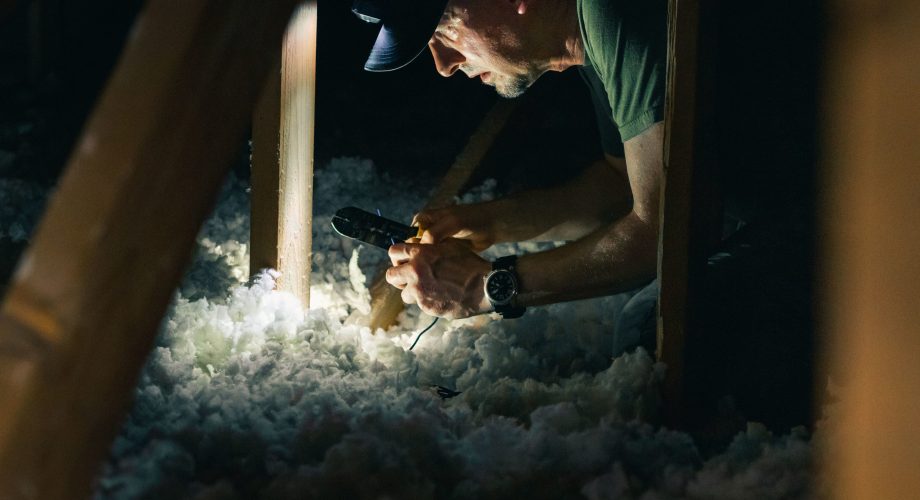Mold is a problem that just about everyone has to deal with at some point or another. It can show up in your home and the workplace, and it may cause health problems for you and those around you if left untreated. The good news is that there are ways to prevent mold from developing – one of which is spray foam insulation. Here’s how spray foam kits work.
Is there mold resistant insulation?
Every type of spray foam has its pros and cons. But our go-to is spray foam insulation.
Spray Foam
This insulation is a spray-on product that helps fill in gaps and crevices. By sealing windows, doors, walls, roofs, and electrical outlets it increases moisture control.
You can use spray foam to decrease mold exposure almost anywhere indoors or outdoors where moisture may come into contact with the material.
Once you spray the foam onto surfaces (or applied inside wall cavities) it expands slightly, filling in spaces and making the area water-resistant, eliminating any mold problem from occurring.
It doubles as insulation and an air sealant.
Spray foam insulation comes in two different forms, open and closed celled:
Open-Cell Foam
Open-cell insulation is a cheaper product with a lower R-value. However, it’s more flexible and can breathe since the open cells allow moisture to escape through evaporation; this makes for an excellent insulator on wood or other materials like concrete blocks that need fresh air circulation but not water penetration.
Open-cell spray foam also allows workability after installation. You can bore holes in plumbing/electrical applications because there are no clumps, just individual pieces. You’ll have less trouble getting your task done smoothly.
Closed-Cell Foam
Closed-cell foam is high-performing insulation that can keep your home warmer in the winter and cooler during summer. Closed cells are not permeable, so they do not allow air or water to get through; this means closed cells provide more value for your money than open cells, which have lower R values but still work similarly enough.
Closed-cell insulation is more rigid and compact than open-cell, which means it can increase the structural soundness of your building when applied.
Can mold survive fiberglass insulation?
We wanted to give this one its own section because it’s a question that we get a lot.
Since fiberglass is essentially shredded glass, you might think it can’t get moldy.
But the thick batt can trap moisture, providing a home for mold.
How do I keep my insulation from molding?
It’s crucial to catch mold as early as possible because it can have adverse health effects. There are a few things you can look for in your home that indicate you have a problem with mold.
Black or Green Spots on Your Walls
Mold can be hard to spot because the black or green spots can be tiny. If you find any on your walls, especially damp basement walls or crawl spaces, it’s crucial that you deal with it quickly before the mold spreads and creates a significant problem for your home.
Musty Smell
A musty odor consistent throughout every room in a persistent manner may be an immediate indicator that you could have mold growing. This could be from too much indoor humidity, a common cause of a musty smell in your carpet or the air.
Allergy Symptoms
One of the most common signs of mold comes from your own body. Inhaling mold can cause allergies to develop. Symptoms may include coughing and sneezing, lightheadedness, or other respiratory problems. Don’t ignore your body when you experience these symptoms! Schedule an appointment with a doctor who can tell you if there are any indications that you are inhaling mold; doctors often use special tools like Fungitell testing kits designed for this type of work.
Causes of Mold
Mold is often a symptom of more significant problems in your home: water damage, plumbing leaks, or structural issues that produce moisture.
Sometimes people know they’ve experienced recent flooding or burst pipes that can create a wet surface on your walls and ceiling tiles, while other cases go unnoticed. You should take moisture in your home seriously because you may need expensive repairs if you don’t catch it early.
A discolored ceiling can easily get painted over but could hide severe damage like rot, which would cost more money to fix than just repainting.
The mold that grows in our home wants moisture, warm temperatures, and a food source like biodegradable materials. This means bad news for people living in Florida, as we experience most of these things throughout the year. Hurricanes deliver rainfall which causes floods during the storm season, steady rain combined with the proximity to oceans, lakes, and wetlands also causes high humidity levels.
Wet areas are a recipe for mold!
But what if your home hasn’t been flooded? The culprit might be your attic – more specifically, faulty or missing attic insulation, which could also be damaging your home’s energy efficiency. Many people think that insulation’s only job is to keep warm air inside, but that’s not the case. Homes in warm climates need insulation, too. Proper insulation keeps cool air in and moisture out. Gaps in insulation allow humid air to sneak in and take up residence.
Mold’s favorite partner in crime is your HVAC system. Pipes lead air movement into every room in your home. If mold is hiding in areas inside walls or attic spaces, mold spores can enter your air conditioner, spreading (and growing) all over your home. Suddenly your problem just got a lot bigger!
Does spray foam insulation prevent mold?
Adding spray foam insulation in potential problem areas is a great way to insulate your home and goes a long way towards mold prevention. It is mold-resistant because it expands when it gets wet, meaning there’s no room for mold or mildew! It acts as a protective barrier around your home, keeping moisture out while at the same time preventing mold from ever getting in.
Additionally, spray foam insulation is an air barrier, which means that it keeps humid outdoor air out while keeping dry indoor air in. Spray foam insulation keeps your living space free of moisture and allows you to prevent mold growth!
Best insulation to prevent mold
Mold can be a serious health hazard, and it’s important to take the necessary precautions to prevent it. If you have black or green spots near your home, have allergy symptoms from indoor air quality issues, or experience water damage in your home, call us today for a free consultation and ask how we can help with our spray foam insulation services.
We offer solutions that will stop mold growth from the start.
Call us at (855) 928-8123 to protect your home or get help removing mold.

